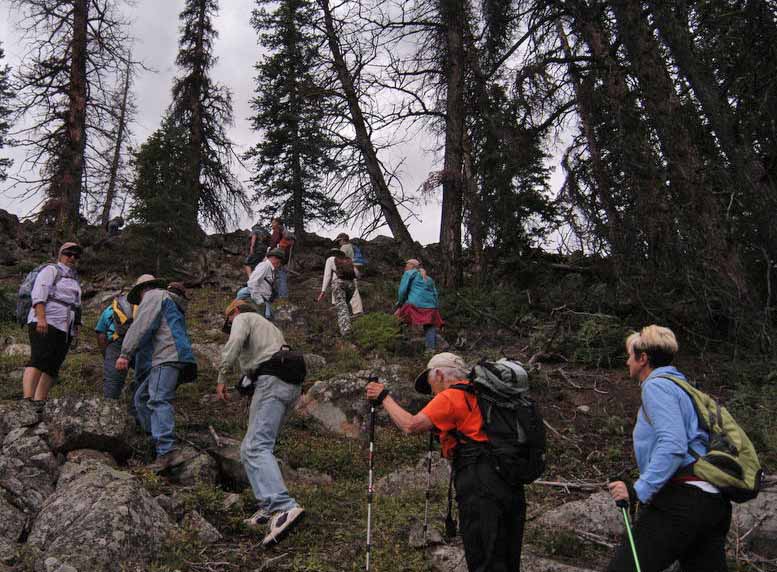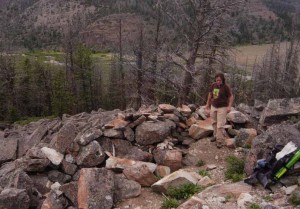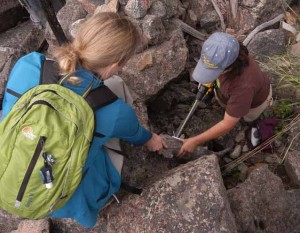
By Ruffin Prevost
MEETEETSE, WYO. — It’s no secret to even casual naturalists that the age of a tree can be determined by counting the rings in its cross-section. But researchers in the greater Yellowstone area are building on that technique and expanding the field of dendrochronology to learn new secrets about how landscapes were affected decades or centuries ago by people, climate and fire.
“We’re interested in learning as much as we can from the wood, in finding out what stories trees tell,” said Marcy Reiser, a dendrochronologist with the Arapaho and Roosevelt National Forests and Pawnee National Grassland in Colorado.
Reiser has been applying forest ecology to archaeological studies in the Wood River area of the Shoshone National Forest, near Meeteetse, Wyo. and southeast of Yellowstone National Park. She spoke last month to participants on a field trip to the forest organized by the Greater Yellowstone Coalition, and demonstrated her field methods for dating trees and log structures.

“We start with living trees and look for patterns in them that we can pick up in other trees,” Reiser said.
Researchers either cut a cross section of a dead tree or use a drill to remove a dowel-shaped core. Then, they measure tree rings down to 1/100th of a millimeter, allowing for a precise and detailed quantification of the growing season for each tree. From those rings, they can tell whether it was a wet or dry year, or a harsh or mild winter. Reiser can point to a string of tight rings and know they represent, for instance, a multi-year drought several decades ago.
By documenting ring patterns across several living trees with known ages, and then locating those same patterns in trees of unknown provenance, she can determine the years during which a tree lived and grew, as well as when it might have been cut for use in a log cabin, or when it died due to fire or other causes. Reiser also can determine the broad climate trends for the life of a tree based on its ring measurements.
The oldest tree Reiser has found in her work around the Wood River area lived from about 1260 until 1719. That means it would have been a seedling when Kublai Khan became ruler of the Mongol empire, and lived until the publication of Pennsylvania’s first newspaper.
Reiser has worked with Meeteetse archaeologist Larry Todd and others to date cabins in the Jack Creek area of the Wood River area, with a goal of learning more about how some of the first white settlers in the Bighorn Basin used the forest.
A look at climate records drawn from tree rings may help explain why cattle baron Otto Franc established the Pitchfork Ranch near Meeteetse in the 1870s, Reiser said.
“When Franc arrived, he may have overestimated the carrying capacity of the land,” she said.

Tree rings from that timeframe show an unusually prolonged wet period — a sort of false lush era — during which the Bighorn Basin experienced far more precipitation than was normal, she said.
Reiser also is studying vast stands of dead trees, measuring their age, spacing and other factors to determine how forest landscapes have changed over the centuries. Such stands of “ghost trees” may include trunks that are more than 1,000 years old, preserved to a remarkable degree in the arid climate, she said.
Trees can also give up their secrets when they have been “culturally modified,” Reiser said. Native populations, for instance may have stripped the bark from a tree for a specific purpose, allowing researchers to help piece together where and when specific peoples moved through a particular area.
They might have peeled back the bark to get at the sap to make a sweet treat, or maybe it was stripped for use as medicine or to mark a trail, Reiser said.
Together with the work of Todd and other archaeologists as part of the Greybull River Sustainable Landscape Ecology project, Reiser is helping to shed new light on a rich but under-appreciated cultural history of the Shoshone Forest, said Charles Drimal, GYC Wyoming Public Lands Advocate.
“It’s so amazing to get a feel for the human pulse of the landscape over thousands of years,” Drimal said.
Drimal’s group is asking members and others to urge the U.S. Forest Service to set aside the Franc’s Peak and Wood River roadless areas as worthy of wilderness designation as part of the current Shoshone Forest management plan revision.
Public comments on the plan are due Nov. 1 and may be sent to [email protected].
Contact Ruffin Prevost at 307-213-9818 or [email protected].
